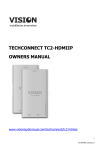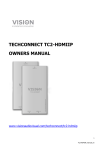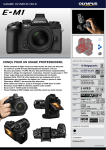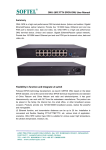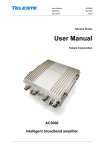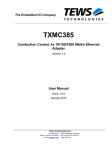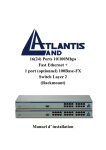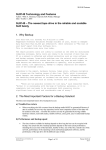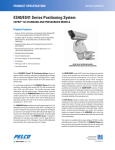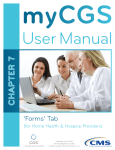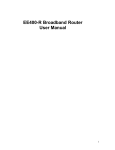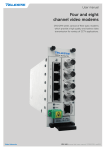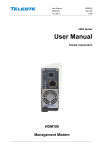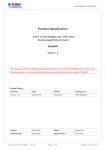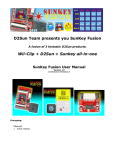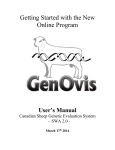Download EoC-C100 - HFC Technics
Transcript
SYSTEM BLOCK DIAGRAM Ethernet to the Home TECHNICAL SPECIFICATIONS ECM, Ethernet Customer Modem EMM, Ethernet Master Modem Fast Ethernet Interface Fast Ethernet Interface Number of ports 1 RJ-45 Number of ports 1 RJ-45 Standard 10/100BaseT IEEE802.3 Standard 10/100BaseT IEEE802.3 Number of ports 1 F female Number of ports 1 F female Protocol PowerLine Protocol PowerLine RF frequency 3...34 MHz channel edge frequency RF frequency 3...34 MHz Nominal RF level 53 dBµV / Hz Nominal RF level 53 dBµV / Hz Line rate 200 Mbs data payload speed up to 100 Mbs Line rate 200 Mbs Supported ECM’s 32 pcs 16 pcs if VLAN tagging is used MAC addresses 64 EoC-C100 channel edge frequency data payload speed up to 100 Mbs General General Power consumption 6W Power consumption 6W Supply voltage 85 VAC to 265 VAC or 24 VDC via backplane Supply voltage 85 VAC to 230 VAC Dimensions (h x w x d ) 250 x 40 x 85 mm Dimensions (h x w x d ) 40 x 145 x 105 mm Environment IP40 -20...+55 °C Ordering information: ECM100 Ordering information: EMM300 Field hardened only EU power cable included EMM301 Indoor only EU power cable included Package contents: EoC-C modem, 1 CAT5 Ethernet cable 1 coax cable (F-male to IEC), 1 AC power cable (EU model, UK model not included), 1 coax splitter, User Manual EPC700 UK power cable Note ! Docsis / EoC-C diplexer not included to EMM EPC700 UK power cable TELESTE BROADBAND CABLE NETWORKS P.O. Box 323, FIN-20101 Turku, Finland, Phone +358-2-2605 611, Fax +358-2-2605 779 www.teleste.com PET205 E V.1.0 05/06 - Copyright © TELESTE CORPORATION 2006. We reserve the right to make changes without prior notice. Cable Interface Cable Interface ETHERNET TO THE HOME Ethernet to the Home is a product platform which consists of subproduct families that are independent yet compatible. The common denominator for all these product families is their capability to simultaneously bring high speed data services over HFC networks and keep existing TV services running. The EMM Ethernet Master Modem is available in two different cases. The field hardened version is intended for street cabinet or basement installations where high temperatures and dust are every day enemies. In addition, it supports a wide range of powering options such as remote and DC powering. The non-field-hardened case is a cost-effective alternative if the master modem is installed inside and normal mains is available for powering. Data port (100BaseT) for connecting to the VF or any other data source. EoC-C100 Ethernet over Coax – Cascaded 100Mbs is an independent part of the ETTH solution. It enables a symmetrical 100Mbs data connection for each end user through existing TV wall outlets. The EoC-C can be fed with any standard Ethernet data source such as Virtual Fibre or Baseband fibre, just to mention a few. To get an idea of what EoC-C is all about a rough comparison between Docsis may help. The EoC-C master modem can be compared to a CMTS and the EoC-C customer modem to a cable modem. However, the EoC-C throughput of 100Mbs is higher and its robust OFDM modulation is allowing to connect to homes which have been impossible to enter with Docsis. The ECM Ethernet Customer Modem is a Simple powering from mains, no additional adapters needed. BK housing can be installed to standard BK racks or used as a stand alone. 10 / 100 BaseT RJ-45 SIMPLE SOLUTION, ADVANCED FEATURES RF port feeding 100 Mb to network. FEATURES AND BENEFITS • Symmetrical 100Mbs per home • No infrastructure changes, supports existing wall outlets • Ingress tolerant OFDM modulation • Simple “one time” installation, no Powering from mains if BK backplane is not used. further visits to the street cabinet • Uses existing coaxial wiring, even if in bad condition • Supports multiple services: Data, Voice (VOIP), Video, games etc. • Extensive dynamic range • High reliability • Advanced security features • Fits to FTTC/FTTB/FTTH roadmaps F female for RF connection compact and streamlined consumer device which can be used to bring data in several rooms of a single household or connecting multiple houses to a shared access point. The ECM has only one Ethernet port and no integrated VOIP phone. This is a deliberate strategy and results in an extremely cost effective 100Mbs home device, which performs only evident functions required now and in the future. In multiplay environment operators can choose their own Ethernet based CPE whether it is an MTA or IP STB. Often end users need different products and integrating them into a single device would outdate the device before repayment period. The EMM Ethernet Master Modem integrated & rugged 100Mbs capacity can be used to DSL type of asymmetrical connections or LAN type of symmetrical connections. 100Mbs is shared between up and downstream, and this provides the option to sell connections such as 80Mbs/20Mbs or 50Mbs/50Mbs. Note that even in these cases the peak rate of 100Mbs can be offered and it is fully up to operator how much he wants to give guaranteed bandwidth. Extensive dynamic range up to 80dB makes it possible to use networks that one may think to be old fashioned. For instance you can bypass amplifiers passively and dramatically reduce existing upstream problems. Network loss is of course effecting to the throughput, but less than one would expect. Full throughput of 100Mbs is achieved even with 40dB network loss, and with 60dB loss the operator is still capable of offering 40Mbs connections. In addition to all this, the above mentioned losses are network losses of low frequencies, the frequencies known to be runways of coaxial cables. Ingress tolerant OFDM modulation was originally used for military applications where trouble-free connections in every case are essential. Current development of computing power is now bringing this sophisticated modulation method available for operators, and formerly “polluted” networks are now highways for internet. The OFDM uses thousands of carriers next to each other intead of just one carrier. These carriers are independent, and even high level ingress peaks only disturb one or two carriers. One lost carrier means only a 1% reduction in throughput and it will be invisible for the end user even when watching HDTV over EoC-C. EoC-C fi ts into your FTTX roadmap. It is a generally accepted idea that fibre will penetrate deeper into the network and that the fibre in HFC will become more prominent over time, eventually leading to FTTB and FTTC type networks. The coax cabling that enters the subscriber premises, however, is one of the biggest assets of a cable operator, and also the most expensive to replace with fibre. EoC-C allows FTTH performance to be brought over by using existing coax cabling, and thus protects the competitive strength of the cable operator. The investment into EoC-C100 is the most future-proof option with regards to a deep-fibre roadmap because it can work today with the use of an HFC feeder, but also tomorrow when standard GbE over fibre is available to create FTTB/FTTC networks. ETHERNET TO THE HOME Ethernet to the Home is a product platform which consists of subproduct families that are independent yet compatible. The common denominator for all these product families is their capability to simultaneously bring high speed data services over HFC networks and keep existing TV services running. The EMM Ethernet Master Modem is available in two different cases. The field hardened version is intended for street cabinet or basement installations where high temperatures and dust are every day enemies. In addition, it supports a wide range of powering options such as remote and DC powering. The non-field-hardened case is a cost-effective alternative if the master modem is installed inside and normal mains is available for powering. Data port (100BaseT) for connecting to the VF or any other data source. EoC-C100 Ethernet over Coax – Cascaded 100Mbs is an independent part of the ETTH solution. It enables a symmetrical 100Mbs data connection for each end user through existing TV wall outlets. The EoC-C can be fed with any standard Ethernet data source such as Virtual Fibre or Baseband fibre, just to mention a few. To get an idea of what EoC-C is all about a rough comparison between Docsis may help. The EoC-C master modem can be compared to a CMTS and the EoC-C customer modem to a cable modem. However, the EoC-C throughput of 100Mbs is higher and its robust OFDM modulation is allowing to connect to homes which have been impossible to enter with Docsis. The ECM Ethernet Customer Modem is a Simple powering from mains, no additional adapters needed. BK housing can be installed to standard BK racks or used as a stand alone. 10 / 100 BaseT RJ-45 SIMPLE SOLUTION, ADVANCED FEATURES RF port feeding 100 Mb to network. FEATURES AND BENEFITS • Symmetrical 100Mbs per home • No infrastructure changes, supports existing wall outlets • Ingress tolerant OFDM modulation • Simple “one time” installation, no Powering from mains if BK backplane is not used. further visits to the street cabinet • Uses existing coaxial wiring, even if in bad condition • Supports multiple services: Data, Voice (VOIP), Video, games etc. • Extensive dynamic range • High reliability • Advanced security features • Fits to FTTC/FTTB/FTTH roadmaps F female for RF connection compact and streamlined consumer device which can be used to bring data in several rooms of a single household or connecting multiple houses to a shared access point. The ECM has only one Ethernet port and no integrated VOIP phone. This is a deliberate strategy and results in an extremely cost effective 100Mbs home device, which performs only evident functions required now and in the future. In multiplay environment operators can choose their own Ethernet based CPE whether it is an MTA or IP STB. Often end users need different products and integrating them into a single device would outdate the device before repayment period. The EMM Ethernet Master Modem integrated & rugged 100Mbs capacity can be used to DSL type of asymmetrical connections or LAN type of symmetrical connections. 100Mbs is shared between up and downstream, and this provides the option to sell connections such as 80Mbs/20Mbs or 50Mbs/50Mbs. Note that even in these cases the peak rate of 100Mbs can be offered and it is fully up to operator how much he wants to give guaranteed bandwidth. Extensive dynamic range up to 80dB makes it possible to use networks that one may think to be old fashioned. For instance you can bypass amplifiers passively and dramatically reduce existing upstream problems. Network loss is of course effecting to the throughput, but less than one would expect. Full throughput of 100Mbs is achieved even with 40dB network loss, and with 60dB loss the operator is still capable of offering 40Mbs connections. In addition to all this, the above mentioned losses are network losses of low frequencies, the frequencies known to be runways of coaxial cables. Ingress tolerant OFDM modulation was originally used for military applications where trouble-free connections in every case are essential. Current development of computing power is now bringing this sophisticated modulation method available for operators, and formerly “polluted” networks are now highways for internet. The OFDM uses thousands of carriers next to each other intead of just one carrier. These carriers are independent, and even high level ingress peaks only disturb one or two carriers. One lost carrier means only a 1% reduction in throughput and it will be invisible for the end user even when watching HDTV over EoC-C. EoC-C fi ts into your FTTX roadmap. It is a generally accepted idea that fibre will penetrate deeper into the network and that the fibre in HFC will become more prominent over time, eventually leading to FTTB and FTTC type networks. The coax cabling that enters the subscriber premises, however, is one of the biggest assets of a cable operator, and also the most expensive to replace with fibre. EoC-C allows FTTH performance to be brought over by using existing coax cabling, and thus protects the competitive strength of the cable operator. The investment into EoC-C100 is the most future-proof option with regards to a deep-fibre roadmap because it can work today with the use of an HFC feeder, but also tomorrow when standard GbE over fibre is available to create FTTB/FTTC networks. SYSTEM BLOCK DIAGRAM Ethernet to the Home TECHNICAL SPECIFICATIONS ECM, Ethernet Customer Modem EMM, Ethernet Master Modem Fast Ethernet Interface Fast Ethernet Interface Number of ports 1 RJ-45 Number of ports 1 RJ-45 Standard 10/100BaseT IEEE802.3 Standard 10/100BaseT IEEE802.3 Number of ports 1 F female Number of ports 1 F female Protocol PowerLine Protocol PowerLine RF frequency 3...34 MHz channel edge frequency RF frequency 3...34 MHz Nominal RF level 53 dBµV / Hz Nominal RF level 53 dBµV / Hz Line rate 200 Mbs data payload speed up to 100 Mbs Line rate 200 Mbs Supported ECM’s 32 pcs 16 pcs if VLAN tagging is used MAC addresses 64 EoC-C100 channel edge frequency data payload speed up to 100 Mbs General General Power consumption 6W Power consumption 6W Supply voltage 85 VAC to 265 VAC or 24 VDC via backplane Supply voltage 85 VAC to 230 VAC Dimensions (h x w x d ) 250 x 40 x 85 mm Dimensions (h x w x d ) 40 x 145 x 105 mm Environment IP40 -20...+55 °C Ordering information: ECM100 Ordering information: EMM300 Field hardened only EU power cable included EMM301 Indoor only EU power cable included Package contents: EoC-C modem, 1 CAT5 Ethernet cable 1 coax cable (F-male to IEC), 1 AC power cable (EU model, UK model not included), 1 coax splitter, User Manual EPC700 UK power cable Note ! Docsis / EoC-C diplexer not included to EMM EPC700 UK power cable TELESTE BROADBAND CABLE NETWORKS P.O. Box 323, FIN-20101 Turku, Finland, Phone +358-2-2605 611, Fax +358-2-2605 779 www.teleste.com PET205 E V.1.0 05/06 - Copyright © TELESTE CORPORATION 2006. We reserve the right to make changes without prior notice. Cable Interface Cable Interface




